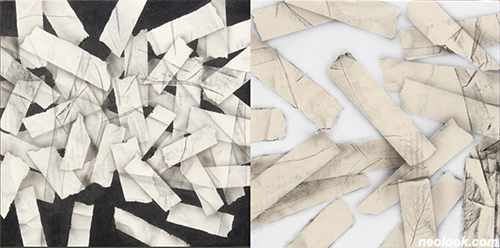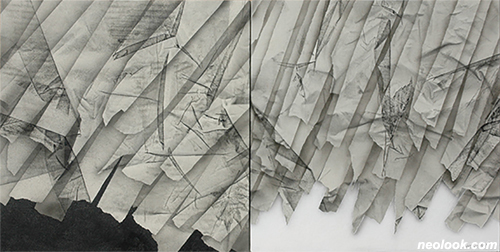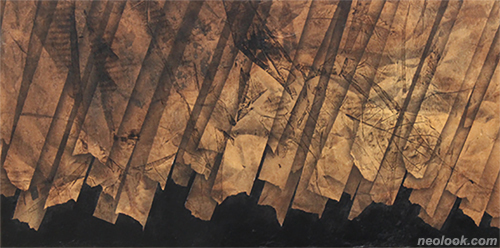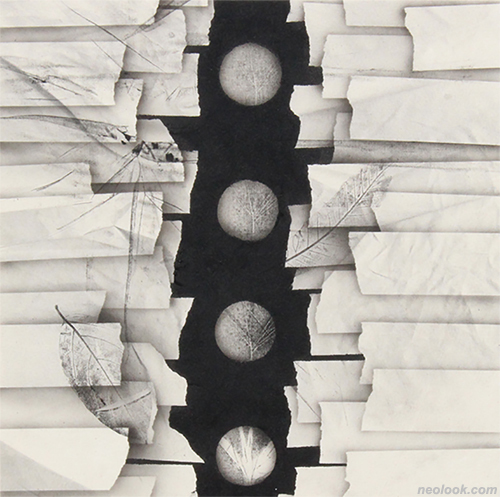- ● homepage
- ● archives
- ● restoration
- ● books
- ● big banners
- ● post board
- ■ neo's search
- ■ about us
- ■ 게재방법 안내
- 개인정보처리방침

- [email protected]
- Tel. 02_335_7922
- Fax. 02_335_7929
- 10:00am~04:30pm
- 월요일~금요일
- 3/3(월) 대체공휴일

최필규展 / CHOIPILKYU / 崔弼圭 / painting 2017_0627 ▶ 2017_0704
● 위 이미지를 클릭하면 네오룩 아카이브 Vol.20151016d | 최필규展으로 갑니다.
별도의 초대일시가 없습니다.
관람시간 / 11:00am~06:00pm
갤러리 한옥 GALLERY HANOK 서울 종로구 북촌로11길 4(가회동 30-10번지) Tel. +82.(0)2.3679.3424 galleryhanok.blog.me www.facebook.com/galleryHANOK
최필규-내면으로부터 표상된 흔(痕):흔적의 경계 ● 최필규의 작품에는 시공간을 통해 자신이 기억의 흔적들이 담겨져 있다. 이처럼 기억의 흔적들로 이루어진 은밀한 독백방식은 자기 과시나 주장을 배제한 스스로의 흔적이다. 작가는 기억의 흔적들을 '흔(痕)'이라는 콘셉트로 펼쳐 가고 있다. 이미지를 배열하고 '흔적'들의 일루전을 표상시키는 과정은 작품의 이미지를 더욱 깊이 있게 창출 할 수 있는 훌륭한 모티브로 보인다. 이를 바탕으로 그는 공간과 시간성을 중시하며, 일종의 조형적 관념성이라고 간주되는 '허구성'과 '소멸성'에 관심을 가져왔다. 작가 최필규는 한지, 종이, 광목 등을 사용하여 구기고 찢는 흔적들의 표상을 보여 준다.

- 최필규_痕-흔적 17503_리넨에 아크릴채색_43×83cm_2017

- 최필규_痕-문 門 17502_혼합재료_37×110cm_2017

- 최필규_痕-흔적 17504_리넨에 아크릴채색_43×83cm_2017
특히 근래 작가의 생활환경이 자연 속으로 그 마음의 중심 축을 옮긴 후 주변의 흔적들을 자연과 교감을 이룬다. 반복되는 표상속에 나뭇잎, 나뭇가지 등의 흔적들을 프로따주 기법으로 표현하고 있다. 우리의 오랜 생활과 문화의 근간이 되어온 재료들로 한지, 광목 등 을 통해 자신의 내면세계를 은은하게 투영시켜가며 되새김질하듯 비워내고 다시 자연의 흔적을 덧입히고 있다.

- 최필규_痕-흔적 17505_리넨에 아크릴채색_61×73cm_2017

- 최필규_痕-흔적 17506_리넨에 아크릴채색_61×73cm_2017

- 최필규_痕-흔적 17507_리넨에 아크릴채색_61×73cm_2017

- 최필규_痕-흔적 17508_리넨에 아크릴채색_61×73cm_2017
이런 관점에서 최필규 작품에 내재된 조형적 감각은 곧 무의식 세계와의 교감이다. 교감 속에서 그가 표현해 내는 일루전적인 이미지들은 새로운 경계를 넘어서는 또 다른 의미를 생각하게 한다. 끊임없이 구기고 찢는 반복 과정을 통해 허상의 '비워내기'를 묵묵하게 구현해 내고 있는 작가는 흔(痕):흔적에서 비롯된 감성적인 희열을 맛보고 있는지 모른다. 특유의 화면 구성력과 장식적 감각을 지닌 작가는 인생 중반을 넘어서면서 자연속에서 자신만의 감성으로 '자연으로의 회기'를 향한 조형의 길을 평온하게 열어가고 있다. ■ 홍창호

- 최필규_痕-흔적 17509_라이스 페이퍼에 아크릴채색_40×80cm_2017

- 최필규_痕-흔적 17510_종이에 아크릴채색_40×80cm_2017
Choi Pil-kyu–The Boundary of the Traces; Traces Presented from the Inside ● In Choi's works of art, we see the traces of his memories of time and space. These secret monologues, which consist of those traces, are those of himself removing self-display or self-assertion. The artist develops his traces which remain in his memories as a concept of 'trace' for a Korean word 'heun(흔(痕)'. The process of image display and illusion presentation seems to be a good motif that can create the images of the works more deeply. On a basis of this, he has made much of time and space, and has been interested in fictiveness and extinctiveness which are regarded as a sort of formal ideality. ● As an artist, Choi shows the torn and crumpled symbols of traces with the use of traditional Korean paper hanji, paper, and cotton cloth. Particularly, since his living environment shifted the central axis of his mind to the natural environment, the traces around his life has communed with nature. The traces of leaves and branches are expressed through the repeated images by frottage technique. Through the use of materials like hanji and cotton cloth, which have been cultural bases for our life, he projects his internal world delicately, ruminates and empties it, and then puts the traces of nature upon it again. ● In this respect, the formal sense inherent in his works of art communes with the world of unconsciousness. The illusionistic images emerging from the communion remind us of other meanings beyond new boundaries. He realizes the work of emptying steadily and silently through the repetitive process of endless crumpling and tearing. He probably may be tasting the emotional delight originated in the traces He has his own highly individual frame-configurating ability and decorative sense. Now he is opening the formative way toward the return to nature with his own emotion as he passes the middle of iife. ■ Hong, Chang Ho(Translated by Lee, Kwang Yong)
Vol.20170627d | 최필규展 / CHOIPILKYU / 崔弼圭 / painting

